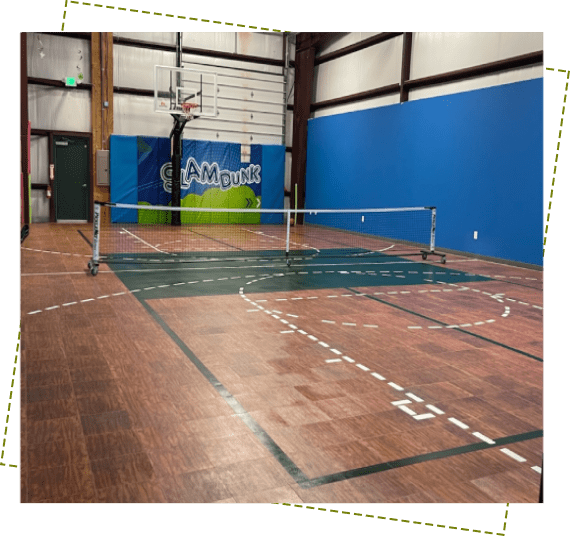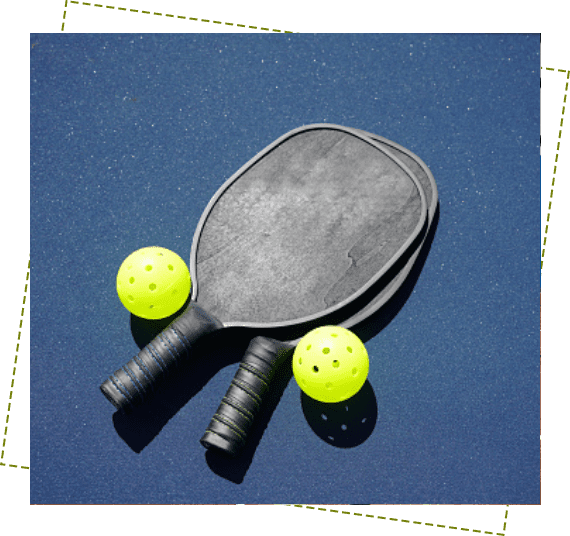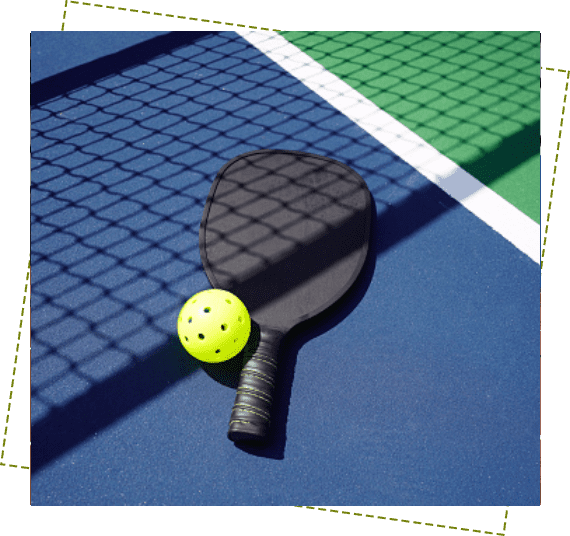What is Pickleball?
Pickleball is a paddle sport that utilizes a combination of components used in other sports. It is basically ping pong meets tennis on a badminton court. The game is played on a surface the size of a badminton court with a tennis-style net, and the balls are similar to those used in Wiffle ball. When invented, the originators used ping pong paddles, but the regulation paddles used today are much larger.
Why Play Pickleball?
Pickleball offers health benefits because it keeps players physically active. However, people play the game because it is fun! Competitors of all ages play it, and there is a social aspect to it that keeps people coming back for more. And while the sport has an element of highly sought after spirited competition, the best players are more focused on strategy than they are on strength and speed.


Brief History
After playing golf one Saturday during the summer, Joel Pritchard, congressperson from Washington State and Bill Bell, successful businessperson, returned to Pritchard’s home on Bainbridge Island, WA (near Seattle) to find their families sitting around with nothing to do. The property had an old badminton court so Pritchard and Bell looked for some badminton equipment and could not find a full set of rackets. They improvised and started playing with ping-pong paddles and a perforated plastic ball. At first, they placed the net at badminton height of sixty inches and volleyed the ball over the net. As the weekend progressed, the players found that the ball bounced well on the asphalt surface and soon the net was lowered to thirty-six inches. The following weekend, Barney McCallum was introduced to the game at Pritchard’s home. Soon, the three men created rules, relying heavily on badminton. They kept in mind the original purpose, which was to provide a game that the whole family could play together.
OPEN-PLAY
Available Every Day as Indicated on the Schedule Below for $9.00 per Session.
Match up the court with players of the same skill level or try your luck with someone that has a higher skill level.
Open -Play is available. Our scheduling system for Open – Play is by ticket on a First Come – First Play Basis with a Max of Ten players per session.
Sessions run every hour during Open - Play. Please arrive 15 minutes prior to the start of your session.
If you would like to reserve space on the court for Private Use, please choose Court Rental.
1. If you do not have a Pickleball Pass, you are still able to pay and play by purchasing a Pass at our checkout counter (As long as there is availability).
2. Pickleball rackets will NOT be given out for use at this time. Please remember to bring your racket.
3. Pickleballs will be available to use (with your valid id). You are more than welcome to bring your own if you prefer.

Open – Play rate of $9 per player per session.
MONDAY
Pickleball Open Play (10 Person Max per session) 5:00 PM–6:00 PM
Pickleball Open Play (10 Person Max per session) 6:00 PM–7:00 PM
Pickleball Open Play (10 Person Max per session) 7:00 PM–8:00 PM
WEDNESDAY
Pickleball Open Play (10 Person Max per session) 8:00 PM–9:00 PM
Pickleball Open Play (10 Person Max per session) 9:00 PM–10:00 PM
Pickleball Open Play (10 Person Max per session) 10:00 PM–11:00 PM
MONDAY
Pickleball Open Play (10 Person Max per session) - 5:00 PM–6:00 PM
Pickleball Open Play (10 Person Max per session) - 6:00 PM–7:00 PM
Pickleball Open Play (10 Person Max per session) - 7:00 PM–8:00 PM
WEDNESDAY
Pickleball Open Play (10 Person Max per session) - 8:00 PM–9:00 PM
Pickleball Open Play (10 Person Max per session) - 9:00 PM–10:00 PM
Pickleball Open Play (10 Person Max per session) - 10:00 PM–11:00 PM
THURSDAY
Pickleball Open Play (10 Person Max per session) 5:00 PM–6:00 PM
Pickleball Open Play (10 Person Max per session) 6:00 PM–7:00 PM
Pickleball Open Play (10 Person Max per session) 7:00 PM–8:00 PM
FRIDAY
Pickleball Open Play (10 Person Max per session) 8:00 PM–9:00 PM
Pickleball Open Play (10 Person Max per session) 7:00 PM–8:00 PM
THURSDAY
Pickleball Open Play (10 Person Max per session) - 5:00 PM–6:00 PM
Pickleball Open Play (10 Person Max per session) - 6:00 PM–7:00 PM
Pickleball Open Play (10 Person Max per session) - 7:00 PM–8:00 PM
FRIDAY
Pickleball Open Play (10 Person Max per session) - 8:00 PM–9:00 PM
Pickleball Open Play (10 Person Max per session) - 7:00 PM–8:00 PM
SATURDAY
Pickleball Open Play (10 Person Max per session) 10:00 AM–11:00 AM
Pickleball Open Play (10 Person Max per session) 11:00 AM –12:00 PM
Pickleball Open Play (10 Person Max per session) 2:00 PM – 3:00 PM
Pickleball Open Play (10 Person Max per session) 3:00 PM – 4:00 PM
Pickleball Open Play (10 Person Max per session) 6:00 PM – 7:00 PM
Pickleball Open Play (10 Person Max per session) 7:00 PM – 8:00 PM
Pickleball Open Play (10 Person Max per session) 8:00 PM – 9:00 PM
SUNDAY
Pickleball Open Play (10 Person Max per session) 10:00 AM–11:00 AM
Pickleball Open Play (10 Person Max per session) 11:00 AM – 2:00 PM
Pickleball Open Play (10 Person Max per session) 2:00 PM – 3:00 PM
Pickleball Open Play (10 Person Max per session) 3:00 PM – 4:00 PM
Pickleball Open Play (10 Person Max per session) 4:00 PM – 5:00 PM

PICKLEBALL GROWTH:
USA Pickleball membership numbers reached the 70,000 marks in February of 2023, after a 30 percent increase in membership growth in 2022. In its 2023 Topline Participation Report, the Sports & Fitness Industry Association (SFIA) named pickleball the fastest-growing sport in America for the third year in a row. According to the report, pickleball is now up to a total of 8.9 million players in the United States over the age of six years old, an increase from 4.8 million in 2022. In March, USA Pickleball and the Professional Pickleball Association announced that the 2023 USA Pickleball National Championships, presented by the PPA Tour, will be held in Dallas this November.
PICKLEBALL SAFETY TIPS:
Pickleball is Friendlier on the body than most other sports. However, like any other sport, there is a risk of injury that comes along with playing Pickleball. To help reduce injuries the following should be adhered to:

BE AWARE OF YOUR PLAYING AREA & ITS OBSTACLES

AVOID BACKPEDALING ON THE PICKLEBALL COURT

STRETCH & WARM UP YOUR BODY BEFORE YOU PLAY

WEAR PROPER COURT SHOES & EYE PROTECTION & USE APPROPRIATE EQUIPMENT

KNOW YOUR BODY & GIVE IT ENOUGH REST

COMMUNICATE WITH YOUR PARTNER TO AVOID CONFUSION
